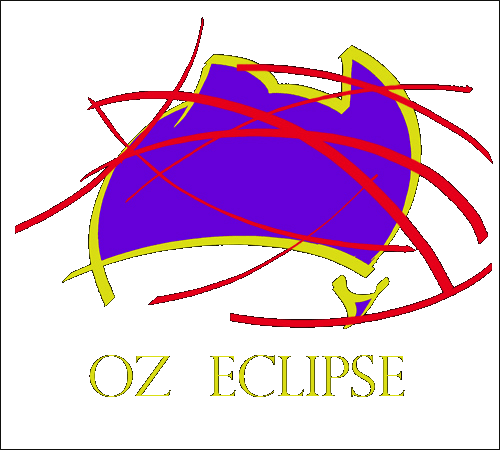






 Cooontaaact!
Cooontaaact!








The solar annulus was twisted and distorted by the atmosphere on the
horizon giving rise to this peculiar shape. This is what we came
to see.
Had the atmospheric conditions been ideal, this is the sort of atmospheric distortion we'd hoped to see...............

I observed severe distortion like this across Lake Eyre in 2011


But we were more than happy to even have views like this............. spectacular.
These photos were taken with a 600mm f7.5 ED refractor which I carried up the hill in three trips.


Below is a frame grab from my HD video cam. It was taken 10 seconds after third contact with the 2000km
thick layer of ionized
hydrogen gas known as the chromosphere is visible joining the two solar
cusps.


We tried some astrophotography from the observing site while conducting the survey. The sky wasn't particularly dark
thanks to mines in the area. This exposure was 300s at ISO800 with a 12mm f4. Camera on fixed tripod. Camera was
guided by the camera's built-in Astrotrace GPS assisted guiding function.
Acknowledgements
Thanks to my main collaborators
Geoff Sims with whom I began
planning this trip during last year's transit of Venus, my traveling
partner in crime,
Bengt Alfredsson and time-lapse photographer
Colin Legg.
Xavier Jubier and Michael Zeiler for invaluable assistance with
calculations and mapping that we used to find the site. Clear
views to an ideal horizon were hard to come by. I am especially
grateful to Colin and Geoff. Colin and Geoff located the southern
site and kindly shared the info with us.
It was nice to meet Eugene and Joerg, a large contingent of Chinese and Chinese Malaysian time-lapse photographers.
A big thanks to Terry Cuttle and Jay Anderson for good company,
weather advice and a much needed beer in Karijini National Park a few
days earlier.
Karijini National Park
Between surveying and the eclipse, Bengt and I went up to Karijini for
a few days. I've wanted to visit this area for many years but
it's a long and expensive trip from Canberra. This eclipse gave
me the perfect excuse to fulfil this longheld ambition to visit this
area. Here are a few shots of the gorges and wildlife.

Dales Gorge
Hancock Gorge



Dales Gorge
..........................................................................................................Hancock Gorge

Hancock Gorge
Hancock Gorge


Australian Native Rainbow Bee. Look carefully,you'll see that native bees have no stinger.
A Spotted Harrier hovers over us at the top of Dales Gorge above Fortescue Falls.


Fortescue Falls and circular pool.
Joe Cali
Return to eclipse home page





























 Dales Gorge
Dales Gorge


 Hancock Gorge
Hancock Gorge
 Australian Native Rainbow Bee. Look carefully,you'll see that native bees have no stinger.
Australian Native Rainbow Bee. Look carefully,you'll see that native bees have no stinger.
 Fortescue Falls and circular pool.
Fortescue Falls and circular pool.